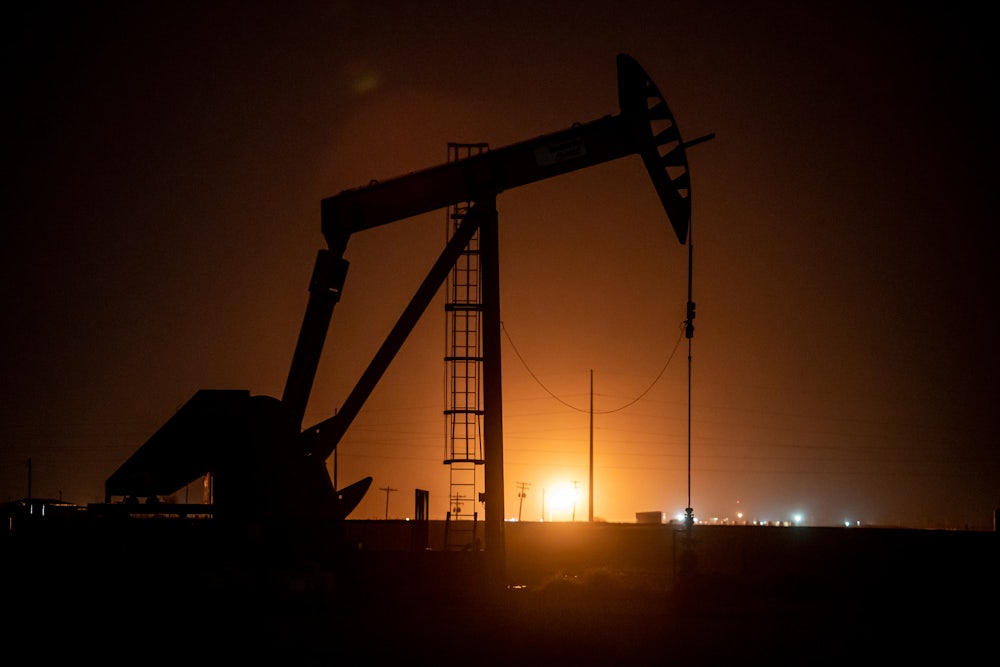July is expected to be Earth’s hottest month ever, amid temperatures that scientists found would be “nearly impossible” without climate change. Parts of the American Southwest have stayed stubbornly north of 100 degrees. Surface temperatures in waters off the coast of Florida have gotten so hot as to make the Atlantic Ocean feel like a bathtub, bleaching coral reefs. At least 100 people were killed in record flooding across Northern India. Usually idyllic Greek islands have caught fire.
The bad news doesn’t stop there, though: In the second fiscal quarter of 2023, Chevron announced that it only made $6 billion.
Chevron’s earnings, previewed earlier this week, beat expectations on Wall Street but still fell nearly 50 percent below those made in the same quarter last year. That’s thanks mostly to lower prices in crude oil and natural gas over the last few months. But as more companies prepare to announce Q2 earnings through the end of the month, executives and their lobbyists will—as ever—point to any evidence they can to blame the White House for villainizing energy companies, raising prices and threatening energy security.
That whining tends to follow some familiar patterns. This week, the American Petroleum Institute railed against the Interior Department’s newly announced plan to raise fees for extraction on public lands for the first time in more than 100 years. That modest hike would raise $1.8 billion through 2031. For reference, Chevron alone made $35.5 billion in profits last year.
“Since Day One, the Biden administration has hampered American energy—canceling the Keystone XL pipeline project, limiting production on federal lands and more,” API executive vice president and chief advocacy officer Amanda Eversole wrote in a blog post on Monday. “Now they are continuing their crusade against domestic oil and natural gas.”
Core to the industry’s apocalyptic talking points has been the idea that markets are underinvesting in oil and gas development, threatening a supply crunch that could send fuel prices skyrocketing. API and others in the industry argue that trend has been due to the White House creating an uncertain environment for investors through bad vibes and regulations, despite the administration’s continued appeals to the industry and unprecedented subsidies. Chevron CEO Mike Wirth has complained in recent months that governments’ hasty embrace of climate policy has created a world where spending on fossil fuels is “woefully short, trillions of dollars short,” pointing to the fact that investment in exploration and production is about half of what it was in the years before the pandemic.
Two recent reports prove him wrong. Energy consultancy Wood Mackenzie finds that current levels of investment are enough to meet demand through a peak expected sometime in the early 2030s and as demand enters a long-term decline beyond that. That’s thanks to efficiency improvements, the development of low-cost reserves, and capital discipline enforced by corporate managers and investors. Shale oil wells in the United States, for instance, generate nearly three times more production for the same cost as they did in 2014: Drillers are doing more with less.
The Norwegian firm Rystad Energy similarly concludes that talk of underinvestment is “overblown” and that increased efficiency means “activity and production remain healthy.”
Healthy is in the eye of the beholder; Wood Mackenzie notes that keeping spending at current levels—around $500 million in 2023 terms—will be enough to meet energy demand but also “leave the world well short of the goals of the Paris Agreement to limit global warming to less than 1.5 °C [2.7 degrees Fahrenheit].” We’d instead be on track for 2.5 degrees Celsius of warming.
At two degrees of warming, 37 percent of the world’s population can be expected to face severe heat waves every five years. Temperatures rising beyond that could see three billion people experience chronic water scarcity, low-lying nations submerged, and large parts of the tropics and subtropics rendered too hot for human life during large parts of the year. Sea levels could rise by several feet as ice sheets are destabilized. Coral reefs may vanish entirely.
Exceeding two degrees amplifies the risk of passing several important tipping points, which would cause irreversible changes to Earth’s systems. Global average temperatures are now about 1.1 degrees warmer than preindustrial levels, and scientists warn the world may already be on the brink of a mass melting of carbon-rich permafrost and several other such thresholds. Just this week, scientists found that a key ocean current is weaker than it has been in 1,600 years, thanks to an influx of freshwater from melting ice caps in Greenland. It could collapse by the end of the century, or even as soon as 2025, threatening rain patterns that billions depend on for food.
But levels of fossil fuel spending consistent with 2.5 degrees Celsius of warming certainly aren’t the limit. Wood Mackenzie analysts predict that fossil fuel producers could keep investing in making more supply “because it buys into the underinvestment story.”
And fossil fuel executives have proven all too eager to lay blame at the feet of the administration for the sob story they’re trying to tell. In a letter sent to Biden amid rising fuel prices last year, Wirth accused the administration of seeking “to criticize, and at times vilify, our industry.” He added that “bringing prices down and increasing supply will require a change in approach,” imploring the White House to offer “cooperation and support” to the energy sector.
What’s troubling is that the administration still seems to be buying the industry’s false underinvestment narrative too, rankled by the prospect of higher gas prices.
“We want to see more supply,” Energy Secretary Jennifer Granholm told CNBC this week. “It gets dangerous when the prices are so high. I think the prudent course is to ensure that transportation is affordable for people, and that of course means making sure that supply is stable.”










